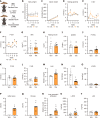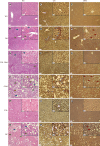Myeloperoxidase, extracellular DNA and neutrophil extracellular trap formation in the animal models of metabolic dysfunction-associated steatotic liver disease
- PMID: 40741100
- PMCID: PMC12305155
- DOI: 10.3748/wjg.v31.i27.106166
Myeloperoxidase, extracellular DNA and neutrophil extracellular trap formation in the animal models of metabolic dysfunction-associated steatotic liver disease
Abstract
Background: Metabolic dysfunction-associated steatotic liver disease (MASLD) is a prevalent chronic liver disorder driven by obesity and metabolic dysfunction. MASLD progresses to metabolic dysfunction-associated steatohepatitis, which is characterized by inflammation, hepatocyte injury, and fibrosis, increasing the risk of cirrhosis and liver failure. Recent studies suggest that neutrophil extracellular traps (NETs) and extracellular DNA (ecDNA) contribute to liver inflammation and fibrogenesis. However, their role in MASLD pathogenesis remains incompletely understood.
Aim: To investigate the dynamics of circulating NETs and ecDNA as potential biomarkers of liver injury in MASLD.
Methods: Using three complementary mouse models, thioacetamide (TAA)-induced fibrosis, choline-deficient L-amino acid-defined (CDAA) diet-induced metabolic dysfunction-associated steatohepatitis, and cafeteria (CAF) diet-induced MASLD, we assessed the association between NET-related markers and liver damage. Blood samples were collected biweekly to analyze ecDNA and NET markers, including myeloperoxidase (MPO) and MPO-DNA complexes, using ELISA and real-time PCR. Liver histopathology was assessed for inflammation, fibrosis, and neutrophil infiltration.
Results: The TAA and CDAA models exhibited significant liver injury, characterized by increased plasma alanine aminotransferase and aspartate aminotransferase levels, hepatocellular damage, and fibrosis. Elevated circulating NET markers (MPO and ecDNA) were observed in these models, with a strong correlation between NET formation and liver pathology. The CAF diet model induced steatosis but failed to elicit significant liver fibrosis or an increase in NET markers, suggesting that NETosis is associated with more severe liver damage. Notably, ecDNA and MPO levels correlated with neutrophil infiltration and fibrosis scores, indicating their potential as biomarkers of MASLD progression.
Conclusion: NETosis and ecDNA levels reflect liver injury severity in MASLD. NET markers and liver fibrosis were strongly associated in TAA and CDAA models, whereas CAF model showed minimal NET involvement.
Keywords: Cell-free DNA; Metabolic dysfunction-associated steatotic liver disease; Mouse models; Myeloperoxidase; Neutrophil elastase; Neutrophil extracellular traps; Steatohepatitis.
©The Author(s) 2025. Published by Baishideng Publishing Group Inc. All rights reserved.
Conflict of interest statement
Conflict-of-interest statement: The authors declare no conflicts of interest.
Figures









Similar articles
-
Extracellular vesicles as biomarkers for metabolic dysfunction-associated steatotic liver disease staging using explainable artificial intelligence.World J Gastroenterol. 2025 Jun 14;31(22):106937. doi: 10.3748/wjg.v31.i22.106937. World J Gastroenterol. 2025. PMID: 40539197 Free PMC article.
-
Platelet Functional Profile Is Altered in Metabolic Dysfunction-Associated Steatotic Liver Disease.Liver Int. 2025 Aug;45(8):e70231. doi: 10.1111/liv.70231. Liver Int. 2025. PMID: 40719417 Free PMC article.
-
ACMSD inhibition corrects fibrosis, inflammation, and DNA damage in MASLD/MASH.J Hepatol. 2025 Feb;82(2):174-188. doi: 10.1016/j.jhep.2024.08.009. Epub 2024 Aug 22. J Hepatol. 2025. PMID: 39181211 Free PMC article.
-
Vitamin E improves serum markers and histology in adults with metabolic dysfunction-associated steatotic liver disease: Systematic review and meta-analysis.J Gastroenterol Hepatol. 2024 Dec;39(12):2545-2554. doi: 10.1111/jgh.16723. Epub 2024 Aug 16. J Gastroenterol Hepatol. 2024. PMID: 39150005
-
Silymarin for adults with metabolic dysfunction-associated steatotic liver disease.Cochrane Database Syst Rev. 2025 Jun 24;6(6):CD015524. doi: 10.1002/14651858.CD015524.pub2. Cochrane Database Syst Rev. 2025. PMID: 40552569
References
-
- Younossi ZM, Koenig AB, Abdelatif D, Fazel Y, Henry L, Wymer M. Global epidemiology of nonalcoholic fatty liver disease-Meta-analytic assessment of prevalence, incidence, and outcomes. Hepatology. 2016;64:73–84. - PubMed
-
- Rinella ME, Lazarus JV, Ratziu V, Francque SM, Sanyal AJ, Kanwal F, Romero D, Abdelmalek MF, Anstee QM, Arab JP, Arrese M, Bataller R, Beuers U, Boursier J, Bugianesi E, Byrne CD, Narro GEC, Chowdhury A, Cortez-Pinto H, Cryer DR, Cusi K, El-Kassas M, Klein S, Eskridge W, Fan J, Gawrieh S, Guy CD, Harrison SA, Kim SU, Koot BG, Korenjak M, Kowdley KV, Lacaille F, Loomba R, Mitchell-Thain R, Morgan TR, Powell EE, Roden M, Romero-Gómez M, Silva M, Singh SP, Sookoian SC, Spearman CW, Tiniakos D, Valenti L, Vos MB, Wong VW, Xanthakos S, Yilmaz Y, Younossi Z, Hobbs A, Villota-Rivas M, Newsome PN NAFLD Nomenclature consensus group. A multisociety Delphi consensus statement on new fatty liver disease nomenclature. Ann Hepatol. 2024;29:101133. - PubMed
MeSH terms
Substances
LinkOut - more resources
Full Text Sources
Medical
Research Materials
Miscellaneous

